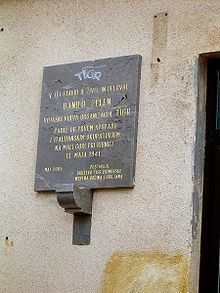TIGR

TIGR (abbreviation for T rst - I stra - G Orica - R ijeka ) was a Slovenian - Croatian underground organization that the time for to connect Fascist Italy belonging to the Slovene and Croatian Littoral (Primorska and Primorje) of Yugoslavia fought.
This mainly Slovene and Croatian-speaking areas had previously served on Austria-Hungary heard and were in the Border Treaty of Rapallo in 1920 in Italy was connected, where she served as Venezia Giulia (Venezia Giulia) were described. TIGR was active in these areas between 1927 and 1941 and is considered to be one of the first anti-fascist resistance movements in Europe . Many of its members had connections with or were trained by the Yugoslav or British secret services. TIGR committed acts of sabotage and carried out numerous militant attacks against fascist institutions.
On March 24, 1929, the Croatian activist Vladimir Gortan was arrested in Pula during an armed action against a referendum, sentenced to death by shooting by a special court in Rome and executed in Pula.
In 1930 the Italian police tracked down several TIGR groups. The TIGR fighters Ferdo Bidovec , Fran Marušič , Zvonimir Miloš and Alojzij Valenčič were sentenced to death and executed in Basovizza near Villa Opicina . However, the organization recovered from this blow and expanded its actions under Albert Rejec and Danilo Zelen . In 1938 TIGR planned an assassination attempt on Benito Mussolini in Caporetto , but the plan had to be abandoned at short notice.
In the 1920s, TIGR had close ties to the nationalist organization ORJUNA in Yugoslavia, but since the 1930s it has turned to the left and established contacts with Italian anti-fascists. In 1935, TIGR signed a cooperation agreement with the Communist Party of Italy . Despite this, TIGR continued to work with local representatives of the Roman Catholic Church and other Slovenian and Croatian groups.
In 1941 the TIGR fighters Viktor Bobek , Ivan Ivančič , Simon Kos and Ivan Vadnal were arrested and sentenced to death for espionage and terrorism and executed in Villa Opicina together with the communist Pino Tomažič . At the time of the attack by the Wehrmacht on Yugoslavia in April 1941, a considerable part of the organization was broken up.
Although TIGR was not invited to participate in the Slovenian Osvobodilna Fronta , many TIGR fighters joined the Yugoslav partisans during World War II . After the victory of the partisans in 1945, the Yugoslav communists hardly allowed a former TIGR fighter to participate in power; rather, they were subject to surveillance by the UDBA until the 1970s . TIGR was initially kept secret in historiography, and it was not until the late 1970s that literature on TIGR was published.
On the occasion of the 50th anniversary of the annexation of the coastal country to Slovenia , the then President of Slovenia, Milan Kučan , awarded TIGR the Golden Badge of Freedom of the Republic of Slovenia (Zlati častni znak svobode Republike Slovenije) .
Web links
Individual evidence
- ↑ Borut Rutar, "Mala gora: Tigrovci v prvem spopadu z okupatorjem 13th maja 1941", Koper: Društvo za negovanje rodoljubnih tradicij TIGR Primorske
literature
- Peter Pirker : Against the “Third Reich”. Sabotage and transnational resistance in Austria and Slovenia 1938–1940. Kitab, Klagenfurt 2010, ISBN 978-3-902585-65-3 .
- Tone Ferenc: Akcije organizacije TIGR v Avstriji in Italiji spomladi 1940 . Ljubljana 1977.
- Dušan Jelinčič: Pod svinčenim nebom: spomini tigrovskega voditelja . Gorica 1994.
- Milica Kacin-Wohinz: Tigr, Borba: Prvi oboroženi antifašizem. Borec, 41 (1), 1989, pp. 13-31.
- this. & Jože Pirjevec: Storia degli sloveni in Italia 1866 - 1998. Venice 1998 (in Italian)
- this. & Marta Verginella: Primorski upor fašizmu 1920-1941 . Ljubljana 2008 ISBN 978-961-213-178-4 .
- Z. Lovec: Primorska od Rapalla do Londonskega memoranduma srečanja. 19 (175), 1995, pp. 160-162.
- Branko Marušič: O TIGRu in tigrovcih po drugi svetovni vojni. Primorska srečanja, 16 (127), 1991, 948-949.
- Tatjana Rejec: Partija in tigrovci. (medvojna in povojna usoda nekaterih vodilnih tigrovcev) . Ljubljana 2006.
- B. Rutar: Andrej Šavli, član vodstva organizacije TIGR, pedagoški in kulturni delavec . Koper, Tolmin 1996.
- P. Stres: Stališče Komunistične partije Slovenije do organizacije TIGR po II. Svetovni vojni. Primorska srečanja, 20 (117), 1996, pp. 18-20.
- Alojz Zidar: TIGR v boju za domovino . Koper, Nova Gorica 1995.
- Vera Brgoč: Žejska tigrovska trojka in njen čas . Postojna 2007.